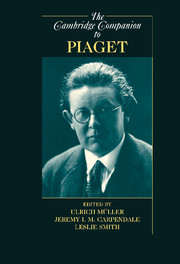Book contents
- Frontmatter
- 1 Introduction: Overview
- 2 The Historical Context Of Piaget’s Ideas
- 3 Piaget’s Developmental Epistemology
- 4 Piaget’s Biology
- 5 On the Concept(s) of the Social in Piaget
- 6 Piaget on Equilibration
- 7 Constructive Processes: Abstraction, Generalization, and Dialectics
- 8 Piaget and Method
- 9 Infancy
- 10 Childhood
- 11 Adolescence
- 12 Piaget’s Theory of Moral Development
- 13 Piaget’s Enduring Contribution to a Science of Consciousness
- 14 Piaget and Affectivity
- 15 Piaget’s Pedagogy
- 16 Piaget in the United States, 1925-1971
- 17 The Mind’s Staircase Revised
- 18 Dynamic Development: A Neo-Piagetian Approach
- Index
10 - Childhood
Published online by Cambridge University Press: 28 March 2010
- Frontmatter
- 1 Introduction: Overview
- 2 The Historical Context Of Piaget’s Ideas
- 3 Piaget’s Developmental Epistemology
- 4 Piaget’s Biology
- 5 On the Concept(s) of the Social in Piaget
- 6 Piaget on Equilibration
- 7 Constructive Processes: Abstraction, Generalization, and Dialectics
- 8 Piaget and Method
- 9 Infancy
- 10 Childhood
- 11 Adolescence
- 12 Piaget’s Theory of Moral Development
- 13 Piaget’s Enduring Contribution to a Science of Consciousness
- 14 Piaget and Affectivity
- 15 Piaget’s Pedagogy
- 16 Piaget in the United States, 1925-1971
- 17 The Mind’s Staircase Revised
- 18 Dynamic Development: A Neo-Piagetian Approach
- Index
Summary
This chapter provides an overview of Piaget's work on cognitive development in childhood, extending from the emergence of symbolic thought at approximately 2 years of age to the emergence of hypothetico-deductive thought beginning in early adolescence. Piaget's research on cognitive development spans 6 decades, starting with his early research on children's understanding of part-whole relations (Piaget, 1921) and concluding with the posthumously published books on the logic of meanings (Piaget & Garcia, 1991) and categories and morphisms (Piaget, Henriques, & Ascher, 1990/1992). What unites this massive research program is Piaget's view of knowledge as constructed through activity (see Chapters 1, 7, this volume).
Two matters complicate a summary of Piaget's theory of cognitive development in childhood. First, Piaget and his collaborators charted children's development in areas as diverse as classification, ordering (seriation), number, geometry, movement, time, causality, physical quantity, memory, imagery, and physics (conservation). Second, Piaget studied developmental changes in the development of reflective abstraction, the grasp of consciousness, the role of contradiction, and generation of possibility and necessity mainly in early and middle childhood (see Chapters 6, 7, 13, this volume). Thus, it is not possible to cover all the areas tackled by Piaget, and we limit ourselves to describing his work on topics that have received considerable attention in the child developmental literature, specifically conservation, seriation, classification, and number.
- Type
- Chapter
- Information
- The Cambridge Companion to Piaget , pp. 229 - 254Publisher: Cambridge University PressPrint publication year: 2009
- 1
- Cited by

